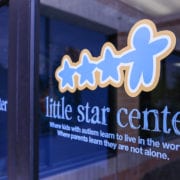Trick-or-Treating: Yes, They Can!
By Dr. Breanne Hartley, BCBA-D
With Halloween coming next week, many parents who are affected by autism may be hesitant to have their children participate in the traditional trick-or-treating festivities.
Many parents I work with at Little Star Center have shared that they want nothing more than for their children to “just be a kid” and participate in all of the fun activities. However, their hesitancy often stems from uneasiness that their child may be too overwhelmed by the whole process of getting dressed into a foreign costume, and having several social interactions with each ring of a new doorbell.
However, don’t ever think “my child can’t do this.” Your child can do this!
Even if it doesn’t appear that your child shows any interest in Halloween festivities, (possibly like your other children, who have been extremely excited to wear their costume for the past several weeks) you can teach your child with autism how fun Halloween really can be. You can do this using an Applied Behavior Analytic teaching method, called pairing (which is the behavioral word for “associating”). The one part of the trick-or-treating festivities that truly makes it Halloween, is wearing a costume. In order to get your child prepared for strolling the neighborhood in costume, start providing some learning opportunities ahead of time. Several days before Halloween, begin dressing your child in their costume, while simultaneously allowing him to play with his favorite toy or eat his favorite snack. At first, just short periods of time of wearing the costume will be sufficient just to get your child accustomed to wearing something different. During that first time, glance at the clock and determine approximately how long your child tolerated having their costume on before they began to tug at it and want it off. This time period will tell you how long to keep it on the next time.
If the first occurrence was a time period of two minutes, then make a mental note to take the costume off at about one minute and 30 seconds the next time. You don’t want you’re your kiddo to exceed his or her limit. Then, over time, with continued practice, gradually increase the amount of time that you keep the costume on. Just remember to “pair” fun things (toys, snacks, movies) with wearing the costume, each and every time. Eventually, your child may begin to learn that Halloween and dressing up in a costume can be quite enjoyable.
Happy trick-or-treating!
Dr. Breanne Hartley is a clinical director at Little Star Center.






